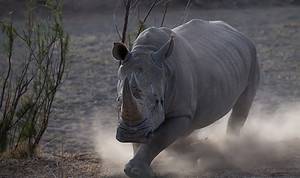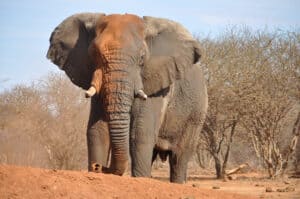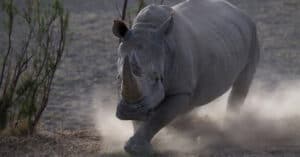Although the rhinoceros is a large mammal with a horn that can demolish some of the deadliest predators in the world, it’s mostly a peaceful herbivore that only attacks to protect itself. Still, how would a battle between the largest bear ever vs a rhino play out in the wild?
Arctotherium angustiden was the largest bear ever found. It weighed 4,000 pounds and stood at about 6 feet on all fours! We’ll show you how it matches up against the largest rhino and which animal could win the battle.
Comparing the Largest Bear Ever and a Rhino
| Largest Bear Ever | Rhino | |
|---|---|---|
| Size | Weight: between 2,000 and 4,500 pounds, probably around 3,800 pounds Height: around 6 feet tall Length: from 11 to 14 feet long | Weight: anywhere from 1,700 to 5,000 pounds, up to 7,700 pounds Height: from 4.3 to 6 feet tall Length: from 11 to 15 feet |
| Speed | – Unknown speed – May run at about 30 mph, similar to its relative, the speckled bear | – Can run at speeds of 24 to 34 mph |
| Defenses | – Large size would help it take damage from predators in a direct fight – Layers of fur, skin, and fat would protect the vital areas – Probably could use its speed to get distance from enemies | – Tough, thick skin that can be as much as 2 inches thick – Can run away from trouble |
| Offensive Capabilities | – Would use its size to overpower other animals – Bite force that was powerful enough to break bones – Probably had claws that could be used to grip prey | – Not an aggressive animal or a hunter – Some rhinos have horns that measure between 8 and 30 inches in length – Rhinos can gore other animals with their horns – Powerful charging ability can knock prey over – Can use their weight to trample prey – May bite with a force over 1,000 PSI |
| Predatory Behavior | – Probably opportunistic hunters that surprised and attacked prey – Scavenged carrion and plant matter | – Herbivorous creature without a prey drive |
What Are the Key Differences Between the Largest Bear Ever and a Rhino?
The most significant differences between the largest bear ever and a rhino can be found in their physical defenses and predatory behavior. The largest bear relied on its size to bring down prey. It counted on its thick skin, dense fur, and layers of fat to grant it a fair measure of protection against most attacks. Meanwhile, the rhino has an outer layer of skin composed of two layers of collagen measuring upwards of two inches thick, protecting them from various predators’ attacks.
The largest bear was an omnivore that had to scavenge and hunt large quantities of meat to maintain its size. Meanwhile, the rhino is an herbivore that eats vegetation and lacks a prey drive. Yet, rhinos are also equipped to attack predators that encroach on their territory.
These are some of the most important differences between the two animals. Yet, we need more information to say which creature wins this fight with any certainty.
What Are the Key Factors in a Fight Between the Largest Bear Ever and a Rhino?
The most important factors in a fight between the largest bear ever and a rhino are size and offensive capabilities. This is not a fight that will be decided by stealth but through brute force and powerful attacks. Still, we want to provide a well-rounded look at each animal before declaring one the winner.
That’s why we will compare these creatures in five different ways. We’ll show which animal has the most advantages over the other and use that data to inform our decision about the winner.
Largest Bear Ever vs. Rhino: Size
The largest bear ever and a rhino are similar in size. The average rhino weighs between 1,700 to 5,000 pounds, stands from 4.3 to 6 feet tall, and measures anywhere from 11 to 15 feet long. Meanwhile, the largest bear probably weighed about 3,800 pounds, stood 6 feet tall at the shoulders, and measured from 11 to 14 feet long.
Still, the largest rhinos can weigh over 7,000 pounds, giving them a slight edge in this case.
Largest Bear Ever vs. Rhino: Speed
A rhino is probably about as fast as the largest bear ever. Most rhinos can run at speeds of 24 to 34 mph. We don’t have much knowledge about the largest bear’s running speed. Still, its closest relative, the speckled bear, can run at about 30 mph. Grizzly bears, some of the largest bears alive today, can run at 35 mph.
All in all, the rhino may have a slight edge in speed.
Largest Bear Ever vs. Rhino: Defenses
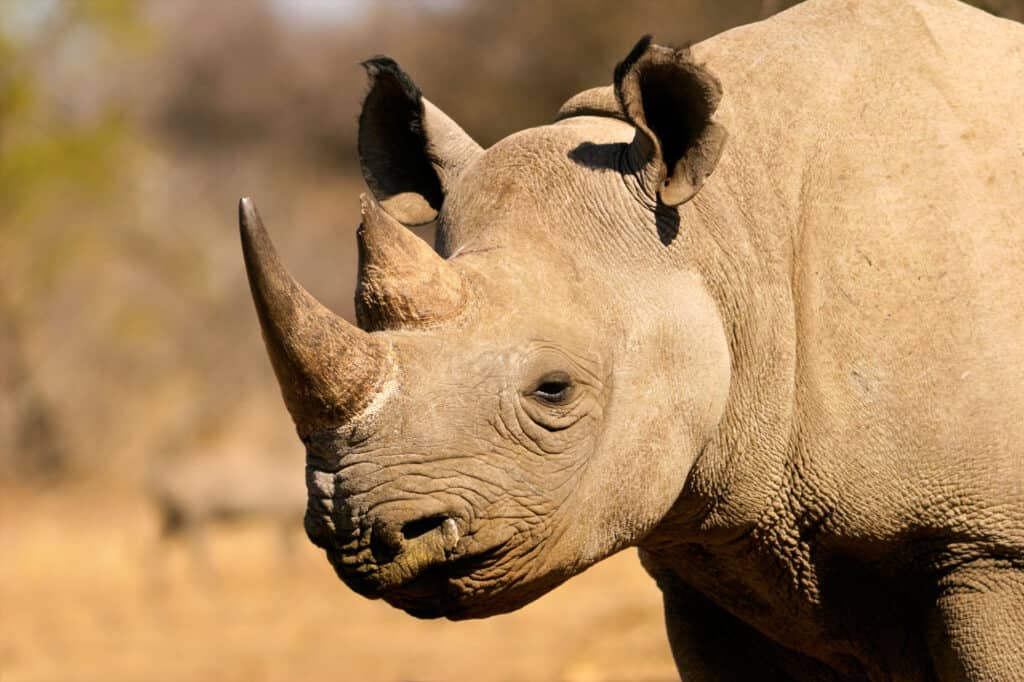
Rhinos have thick skin layers that act as an armor.
©iStock.com/EcoPic
The rhino is well-known for having thick layers of skin that resemble an armor. Their skin comprises two layers of collagen measuring up to 2 inches thick. Adult rhinos can shrug off many attacks, including some from lions and other big cats.
That doesn’t make them invincible, though. Rhinos also flee from many potential fights, especially when outnumbered. It’s rare that they find themselves facing down a larger animal or something their size.
Meanwhile, the largest bear would rely on its bulky body to protect it from harm. Like modern bears, this one would have layers of fur, skin, and fat to protect it from fatal harm. Any attacker foolish enough to go after the bear would have to overcome a lot of defenses to land a killing blow.
The rhino has better defenses since the attacker has to go through so much trouble to even cause a serious wound. Meanwhile, the largest bear would still be harmed during a fight, but its size would keep it upright.
Largest Bear Ever vs. Rhino: Offensive Capabilities
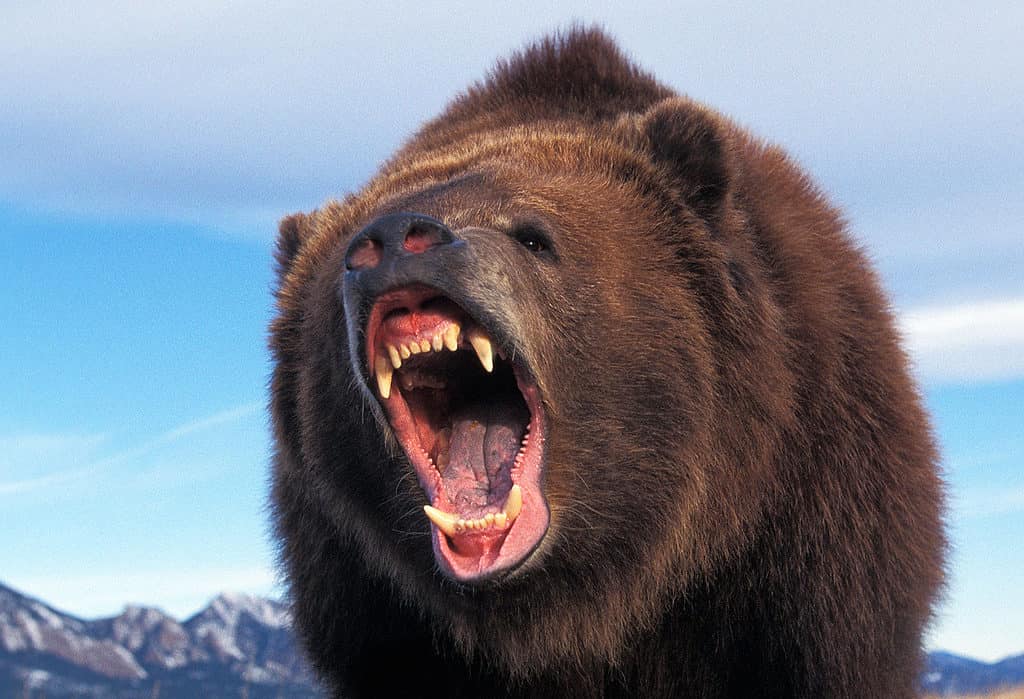
Would a bear win a battle against a Rhino?
©slowmotiongli/Shutterstock.com
We don’t have much information about the largest bear’s offensive capabilities. However, they are estimated to have powerful jaws and teeth capable of breaking bones. The average grizzly bite power is somewhere around 975 PSI. So, it’s not unreasonable to think that the largest bear has a similar power.
The largest bear may have used its weight to mount and drag other prey to the ground. Remember, this bear could stand over 10 feet tall when it reared back on two legs. So, getting to a position where the bear can essentially tackle prey and kill them on the ground would not be difficult.
Rhinos aren’t aggressive unless something encroaches on their territory, threatening them or their young. That being said, they are well-equipped to deal with some of the most dangerous animals on the planet. Rhinos without horns can knock over other animals and trample them to death with their large and heavy bodies.
If a rhino has a horn, it can use them to great effect, goring aggressors and instantly causing a severe or fatal wound if they land the attack. Rhinos can also bite with a force that meets or exceeds 1,000 PSI. Although their teeth aren’t long and sharp like a predator’s, that much force can do serious damage.
The largest bear would have the offensive advantage due to their power and predatory nature.
Largest Bear Ever vs. Rhino: Predatory Behavior
The largest bear ever was omnivorous, often scavenging meat and carrion. However, it was no stranger to hunting. The bear’s hunting instincts would make it a deadly mammal that would probably take down and eat prey while it is still struggling to get out from under its immense body.
Meanwhile, rhinos lack predatory instincts. In this fight, that could cause the rhino to hesitate and not recognize the threat posed to it by the large bear until it’s too late.
In this situation, the largest bear ever has the predatory advantage.
Who Would Win in a Fight Between the Largest Bear Ever and a Rhino?
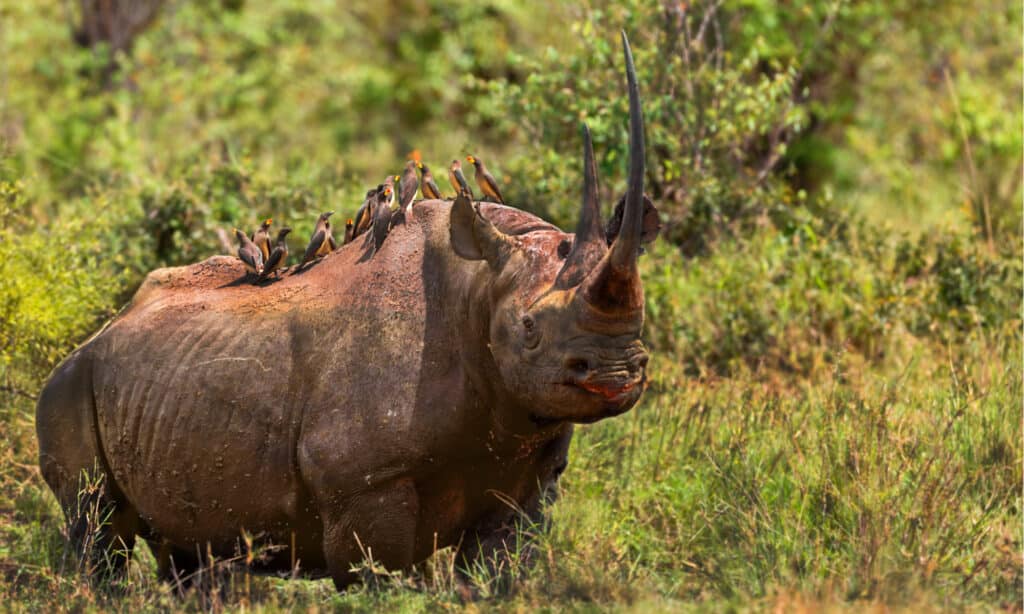
The rhino is more likely to win the fight against the largest bear.
©Maggy Meyer/Shutterstock.com
A rhino would win a fight against the largest bear if it went on the offensive. Arctotherium angustiden was undoubtedly a tough animal. Yet, it may have weighed about 1,000 pounds or less than the average rhino and about half as much as the largest rhinos. They have roughly the same height and length.
That means the bear will not be that successful in its favorite attack method. That is when it attacks by dragging prey to the ground, mounting them, and killing them with vicious bites. The rhino probably has the strength advantage in this case.
In fact, given the thick, tough skin of the rhino, the bear may not even be able to land a good killing blow without putting in some serious work. While it’s trying to kill the rhino, the rhino is going to be counterattacking.
The bear has to get close to the rhino and hope that the large, stable quadruped doesn’t roll over, stomp on its head and neck, or even bite it. Then there’s the matter of the horn! A rhino’s skin is thicker and stronger than any bear’s skin. Even they can’t stop the penetration from another rhino’s horn.
If the rhino successfully gores the bear, the bear will probably die. The horn could puncture a vital organ and cause the bear to die immediately. Otherwise, it could survive the fight by running and die later from infection.
Of course, the bear can win in some cases. They are vicious hunters when they need to eat. In the right circumstances, they probably could have kept the rhino moving until it was tired and then moved in for the kill. However, the bear probably wasn’t going to land an attack that was immediately fatal. That would probably disorient the bear as it would have been used to scoring relatively easy kills.
All in all, the rhino would probably realize that this predator was coming to kill it and fight back with all its power.
What Kind of Animal Could Win a Fight with a Rhino?
There are very few examples in the animal kingdom that could battle a full-grown rhino solo and win. The rhino has too many evolutionary advantages of size, strength, and toughness for almost every other land-dwelling animal to overcome; however, if a fully-grown elephant was defending itself or its young, there is a chance it could not only stop a rhino attack but win the fight as well.
The critical piece to this battle is avoiding a direct hit from a charging rhino’s gore attack. If the elephant could dodge this fierce melee move or take a glancing strike from the rhino’s horn, the elephant could put its own defensive weapons to use and pierce the rhino’s hide with its massive tusks. Once the rhino took its shot and missed, the elephant would perhaps have an advantage in close quarters combat, and that could very well be enough to win the fight!
The photo featured at the top of this post is ©
Sources
- Journal of Paleontology, Available here: https://bioone.org/journals/journal-of-paleontology/volume-85/issue-1/10-037.1/The-Largest-Known-Bear-Arctotherium-angustidens-from-the-Early-Pleistocene/10.1666/10-037.1.short#:~:text=The%20South%20American%20giant%20short,carnivorous%20member%20of%20the%20genus.
- Journal of Paleontology, Available here: https://pubs.geoscienceworld.org/jpaleontol/article-abstract/85/1/69/83937/The-Largest-Known-Bear-Arctotherium-angustidens
Thank you for reading! Have some feedback for us? Contact the AZ Animals editorial team.



